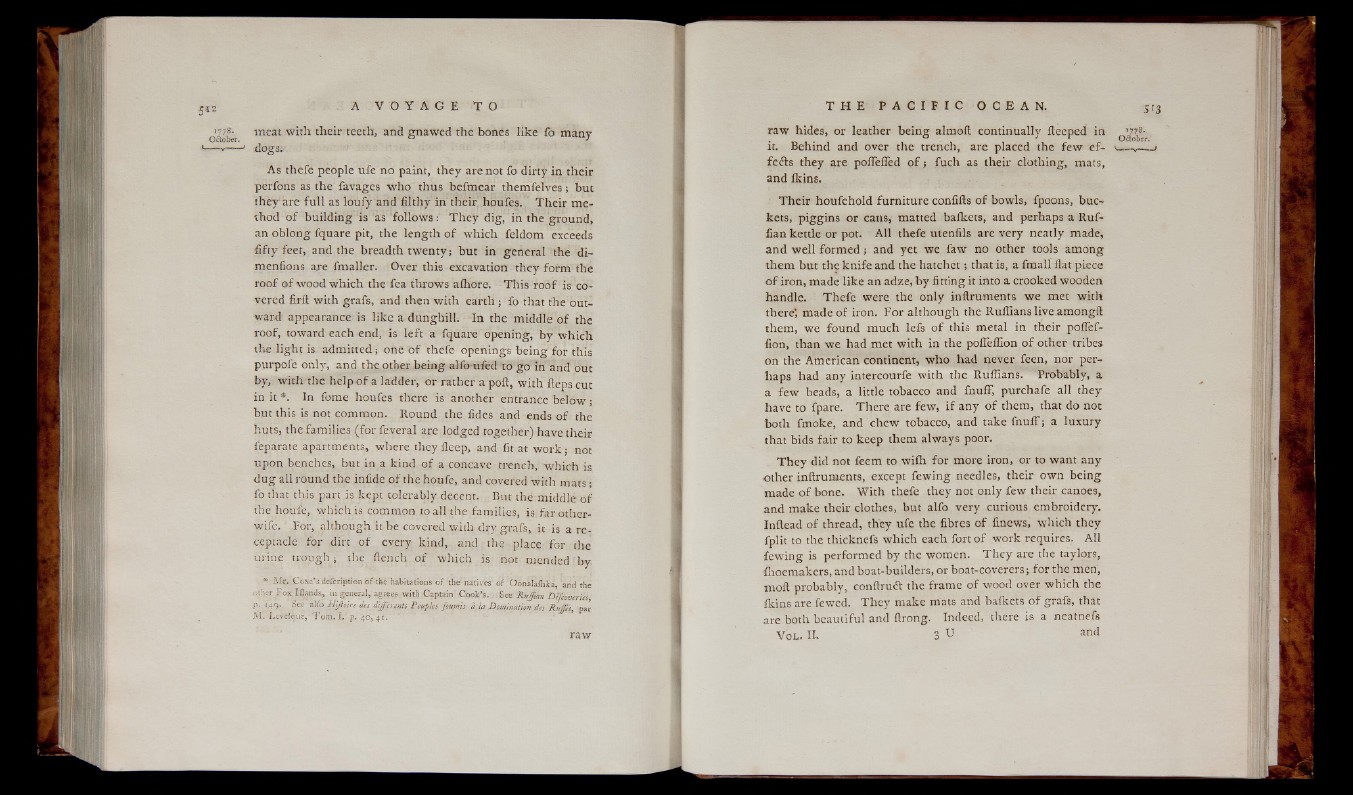
>778- meat with their teeth, and gnawed the bones like fo manv
October. J
1 » ' dogs;
As thefe people ufe no paint, they are not fo dirty in their
perfons as the favages who thus befmear themfelves ; but
th e y are fu ll as loufy and filthy in their houfes. T he ir method
o f building is as ‘follows : T h e y dig, in the ground,
an oblong fquare pit, the length o f which feldom exceeds
fifty feet, and the breadth twen ty; but in general the di-
menfions are fmaller. Over this excavation they form the
roof o f wood w hich the fea throws afhore. This roof is covered
fir ft with grafs, and then with earth ; fo that the outward
appearance is like a dunghill. In the middle o f the
roof, toward each end, is le ft a fquare opening, by which
the ligh t is admitted; one Of thefe openings being for this
purpofe only, and the other being alfo ufed to go in and out
by, with the help o f a ladder, or rather a poll, with fteps cut
in it *. In fome houfes there is another entrance below ;
but this is not common. Round the lides and ends o f the
huts, the families (for feveral are lodged together) have their
feparate apartments, where they ileep, and fit at work ; not
upon benches, but in a kind o f a concave trench, w h ich is
d u g all round the infide o f the houfe, and covered with mats ;
fo that this part is kept tolerably decent. But the middle o f
the houfe, which is common to all the families, ■ far other-
wife. Toi-, although it be covered with dry grafs, it is a re ceptacle
for dirt o f every kind, and the place for the
urine trough ; the ftench o f w hich is not mended by,
* Mr. Coxe’s ‘defcriptron o f thé habitations o f ttitnative s o f Oonàîàihka, ^nd the
other F o x Iflands, in genera], agrees with Captain C'ook’s. - See Ruj/iim Difcm itrus,
P- ‘49- See alfo H ifture des différents Peuples, ftm/nis à. la Domination des Ruffe's, par
■M. Lc.vefque, T om . L p. 40,4.1. ‘ *
raw
raw hides, or leather being almoft continually fteeped in Gj| | |
it. Behind and over the trench, are placed the few ef- t— „—
fe fts they are poffeffed o f ; fuch as their clothing, mats,
and Ikins.
T h e ir houfehold furniture confifts o f bowls, fpoons, buckets,
piggins or cans, matted balkets, and perhaps a Ruffian
kettle or pot. A ll thefe utenfils are very neatly made,
and well fo rm e d ; and yet we faw no other tools among
them but the kn ife and the h a tch e t; that is, a fmall flat piece
o f iron, made lik e an adze, by fitting it into a crooked wooden
handle. T he fe were the only inftruments w e met with
there", made o f iron. For alth ou gh the Ruffians live.amongft
them, we found much lefs o f this metal in their poflef-
fion, than we had met with in the pofleffion o f other tribes
on the American continent, who had never feen, nor perhaps
had any intercourfe with the Ruffians. Probably, a
a few beads, a little tobacco and fnuff, purchafe all they
have to fpare. The re are few , i f any o f them, that do not
both fmoke, and chew tobacco, and take fn u f f ; a luxury
that bids fair to keep them always poor.
T h e y did not feem to w iih for more iron, or to want any
other inftruments, except few ing needles, their own being
made o f bone. With thefe they not only few their canoes,
and make their clothes, but alfo very curious embroidery.
Inftead o f thread, they ufe the fibres o f finews, which they
fplit to the thicknefs which each fort o f work requires. All
few in g is performed by the women. T h e y are the taylors,
fhoemakers, and boat-builders, or boat-coverers; for the men,
moft probably, conftruft the frame o f wood over which the
fkins are fewed. T h e y make mats and baikets o f grafs, that
are both beautiful and ftrong. Indeed, there is a neatnefs
Von. Ik 3 U and